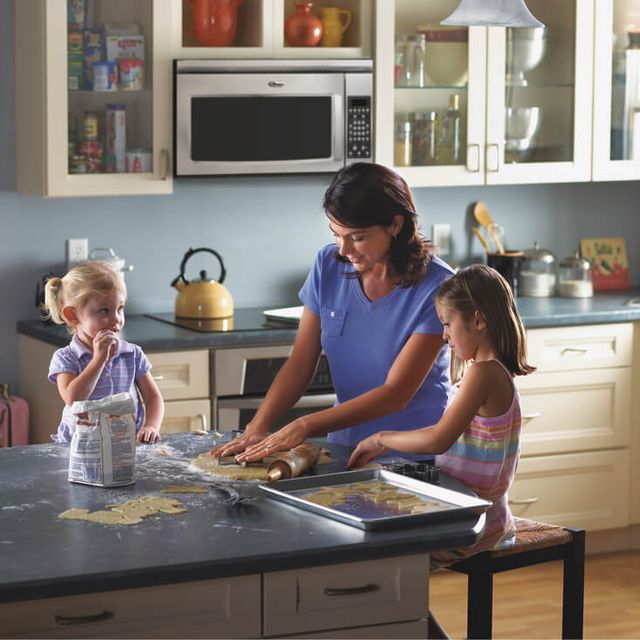
with your kids, think again. It can be fun for them and for you. All you need to do is keep a few things in mind…and keep an open mind.
First, why even bother when you could probably cook and bake more quickly without the help from your children? Well, in addition to that fun we mentioned, cooking and baking can be educational and can introduce them to new foods or might even convince them they like foods they previously hated. And, let them know that cooking and baking as both art and science.
Talk with them about the versatility of foods and let them sample the same food in various ways, such as carrots served raw, baked, in soup and in cakes. Or, have a Month of Potatoes. Once each week feature potatoes, perhaps baked, mashed, or as hash browns or French fries.
Cooking and baking are great ways to teach kids math as you introduce them to measuring cups and spoons. You’ll be surprised at how quickly they catch on to fractions when they’re measuring. Be sure to measure dry ingredients with measuring cups and wet ingredients with glass or plastic measuring cups that have a spout and amount indications. Forget those fancy measuring cups when the kids are learning the ropes. Simple is better. And, a kitchen timer is math at work and can be watched during the countdown to finish.
Start with cute aprons for you and your mini chefs. The aprons add a special touch to the adventure and save that new t-shirt from chocolate smudges or the occasional tipped over bowl. Speaking of bowls, plastic bowls are a better idea than glass ones for the kitchen newbies.
How to choose dishes that are kid friendly and will spur their interest? Make the next trip to the grocery a participatory outing. Let them choose a few ingredients they like. Then, go online together to find easy recipes that use those ingredients. Stick with recipes that call for only a few ingredients and aren’t terribly time consuming. Or, you could buy a kids’ cookbook that will have done that work for you.
GETTING STARTED
- Talk about the importance of not only taste, but also color and texture.
- Have the kids give the fresh fruits and vegetable a water “bath” before using.
- Read to them or help them read through a recipe before beginning.
- Have all the ingredients measured and ready. (This is called mise en place, if you want to use the fancy term.)
- Safety first. Choose small knives that fit small hands. Plastic knives may be a good option. Demonstrate how to roll your fingers under the palm of the hand that’s not holding a knife when you’re chopping or slicing.
- Explain the importance of using different cutting boards for fruits and vegetables, and meats. Let them choose colorful ones in a store or online so they always use the right color. To prevent the cutting board from slipping, put a damp cloth underneath.
BAKING
“Let’s bake” may be the perfect way to switch kids’ interest from the television or computer, even if in the beginning they’re more interested in the end product than in the process!
- Not all cakes are round, so why not let the kids choose round, square or even heartshaped pans?
- Cakes and cupcakes may be as simple or as complicated as you want. Sure, there’s always the box mix, and there’s nothing wrong with that, especially for a novice. It still has the fun of cracking the egg (have them crack each egg separately into a small so that you can remove any tiny shells), measuring the water and oil, and, the best part---mixing everything! Lesson #1: Don’t turn the mixer on high until some of the ingredients are blended. Otherwise, you’ll have a countertop, wall and yourselves covered in what is to become the cake.
- Who doesn’t love chocolate? But your kids may not realize there are different kinds of chocolate, such as milk, semi-sweet, bittersweet, white and cocoa. Bittersweet may be a bit strong for their taste buds but it can taste complexly different to them in a recipe.
- Ok, so you’re graduating or maybe just leaping into making a cake from scratch. Good for you! The kids will enjoy tracing the cake pan circle on waxed paper, if you’re using it in the pans, flouring the pans (sure, you know not all of it will stay in the pans), and spraying the pans with cooking spray.
- It will be hard for them not to peek, but tell them not to open the oven before the desired baking time is up. Otherwise, the cake could be a flat flop.
- Cutting a lattice top and weaving it across the top of a pie is oodles of fun.
- After frosting the cake, kids rarely say no to dressing it up with sprinkles, chopped candy or caramel sauce. Here’s a hint everyone will like: mix some chopped up candy bar (Butterfingers and Nestle’s Crunch are oh-so good) in the frosting. Yum! You can also melt chocolate in molds of various shapes (available online or at stores such as Michael’s.) Freeze them, then flip them out and use as cake decorations.
- Show off the new baking skills by presenting surprise gifts to family and friends.
AND, SOME EXTRAS!
- Take photos or videos of the kids while they’re cooking or baking. The messier, the better! You’ll have sweet memories and plenty of shared laughs.
- Keep copies of all the recipes they prepare and compile them in a one-of-a-kind cookbook. Pictures would be a delicious bonus.
MOST IMPORTANT!
- Not every dish turns out perfectly, and every dish needs a few giggles, oohs and ahhs. The best result? When they say, “Let’s do it again!”